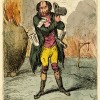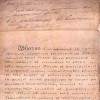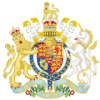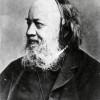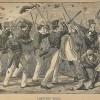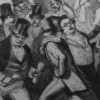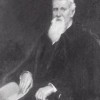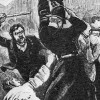Peterloo massacre
16 Aug 1819
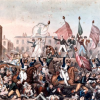 On 16 August 1819, at St. Peter’s Field, Manchester, more than 60,000 workers gathered to demonstrate in favor of an expansion of suffrage in England. In an attempt to disperse the crowd and arrest the organizers of the demonstration, local cavalry and members of the 15th Hussars and 88th Foot attacked the crowd, killing a dozen protestors and injuring as many as 600. Though Wellington was not involved, the incident was dubbed “Peterloo” because of his persistent opposition to reform in the House of Lords. Image: Richard Carlisle, To Henry Hunt, Esq., as chairman of the emeeting assembled in St. Peter's Field, Manchester, sixteenth day of August, 1819, and to the female Reformers of Manchester and the adjacent towns who were exposed to and suffered from the wanton and fiendish attack made on them by that brutal armed force, the Manchester and Cheshire Yeomanry Cavalry, this plate is dedicated by their fellow labourer, Richard Carlile: a coloured engraving that depicts the Peterloo Massacre (1 October 1819), Manchester Library Services. This image is in the public domain in the United States because its copyright has expired.
On 16 August 1819, at St. Peter’s Field, Manchester, more than 60,000 workers gathered to demonstrate in favor of an expansion of suffrage in England. In an attempt to disperse the crowd and arrest the organizers of the demonstration, local cavalry and members of the 15th Hussars and 88th Foot attacked the crowd, killing a dozen protestors and injuring as many as 600. Though Wellington was not involved, the incident was dubbed “Peterloo” because of his persistent opposition to reform in the House of Lords. Image: Richard Carlisle, To Henry Hunt, Esq., as chairman of the emeeting assembled in St. Peter's Field, Manchester, sixteenth day of August, 1819, and to the female Reformers of Manchester and the adjacent towns who were exposed to and suffered from the wanton and fiendish attack made on them by that brutal armed force, the Manchester and Cheshire Yeomanry Cavalry, this plate is dedicated by their fellow labourer, Richard Carlile: a coloured engraving that depicts the Peterloo Massacre (1 October 1819), Manchester Library Services. This image is in the public domain in the United States because its copyright has expired.
Related Articles
James Chandler, “On Peterloo, 16 August 1819″
Sean Grass, “On the Death of the Duke of Wellington, 14 September 1852″
Associated Places
St. Peter's Field in ManchesterCato Street
St Peter's Field, Manchester, England


